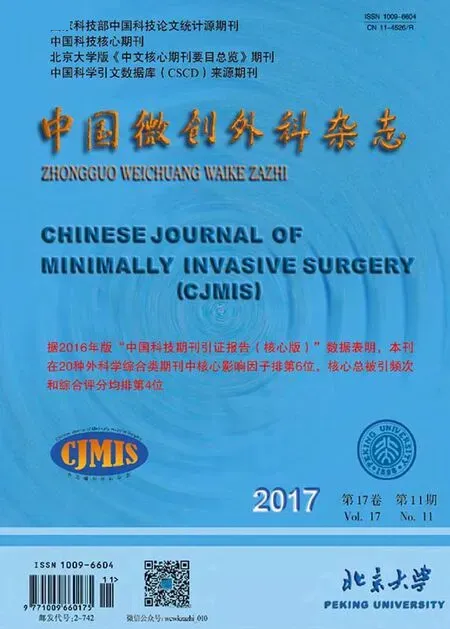关节镜辅助治疗幼儿发育性髋关节脱位长期随访报告
徐会法 黄鲁豫 雷 伟 沙 佳 李 超 徐 超 严亚波 李天清 张春礼
(第四军医大学附属西京医院骨科, 西安 710032)
·临床研究·
关节镜辅助治疗幼儿发育性髋关节脱位长期随访报告
徐会法 黄鲁豫**雷 伟 沙 佳 李 超 徐 超 严亚波 李天清 张春礼
(第四军医大学附属西京医院骨科, 西安 710032)
目的探讨髋关节镜辅助治疗小儿发育性髋关节脱位(developmental dislocation of the hips,DDH)的临床效果。方法2005年1月~2010年 12月采用髋前侧及大粗隆前上入路髋关节镜技术完成 16例(17髋)关节镜下增生滑膜刮除,股骨头圆韧带切除,髋臼底脂肪组织清理, 髋臼横韧带松解,盂唇成形术,术毕髋屈曲外展位管型石膏外固定。术后3、6、9、12个月进行随访,随访12个月时,如果髋臼角>25°二期行髋臼囊外截骨成形、股骨旋转(内翻、短缩)截骨等治疗。随访1年后每6个月随访1次,测量患儿骨盆髋臼角并进行Mckay和Severin评分。结果平均手术时间30.2 min(22~36 min),术中出血平均13.8 ml(10~25 ml),平均住院4.2 d(3~5 d)。16例(17髋)随访60~132个月(中位数91个月),按Mckay标准, 优16髋, 良1髋,优良率100%,按Severin标准,Ⅰ级13髋, Ⅱ级2髋,优良率88.2%(15/17)。结论髋关节镜技术可以使髋关节有效复位、刺激髋臼软骨发育,必要时配合行二期髋臼囊外截骨成形、股骨截骨(旋转、内翻、短缩)是治疗年龄<18个月DDH的有效方法。盂唇外 2/3切开的手术方式,保留内缘完整,能有效防止术后再脱位。
髋关节镜; 发育性髋关节脱位; 髋臼截骨术
发育性髋关节脱位(developmental dislocation of the hips,DDH)是婴幼儿的常见畸形,发病率为0.9‰~35‰[1,2]。治疗策略主要依据患儿年龄而定:年龄<18个月患儿首选闭合复位,但是成功率报道不一, Pavlik吊带治疗发育性髋关节脱位的成功率为74%~96%[3,4];>6个月龄的患儿通常需要闭合复位、管型石膏固定等治疗,Druschel等[5]报道通过MRI扫描检查髋关节脱位闭合复位后股骨头包容情况,发现其中22髋稳定,27髋最终都不稳定。对于闭合复位失败或复位后不稳定的DDH或年龄>18个月的患儿可采用开放手术治疗,但是开放复位最大的风险就是导致股骨头缺血坏。为尽早治疗年龄<18个月的闭合复位失败或复位不稳定的患儿,髋关节镜辅助复位技术成为一种选择,已经有少量文献[6~8]报道,但是普遍病例数较少或者随访时间短。本文对2005年1月~2010年12月16例(17髋)患儿进行长期随访,报道如下。
1 临床资料与方法
1.1 一般资料
本组 16例(17髋), 男3例, 女13例。年龄4~17个月,平均10个月。4例双侧臀纹不对称;6例髋关节弹响;6例跛行步态就诊。右侧6髋, 左侧11髋;单髋15例, 双髋 1例。采用标准骨盆正位片检查确诊。根据Tönnis[9]分级标准分类,Ⅰ度5髋,Ⅱ度6髋,Ⅲ度4髋,Ⅳ度2髋。
病例选择标准:初次就诊且为麻醉后内收肌松解、手法复位失败的DDH,术前实验室检验结果无手术禁忌证。
1.2 方法
采用髋前侧及大粗隆前上入路。前侧入路的穿刺点位于髂前上棘垂线与耻骨联合水平线的交点, 冠状面、矢状面分别偏向内、上各45°。大粗隆前上入路在关节镜下建立。全麻。首先行手法复位, 失败后行经皮内收肌腱切断,仍不能手法复位行关节镜手术。平卧位,患侧髋部垫高。常规使用30°、4 mm关节镜。根据术前体表定位标记, 18号腰穿针髋前部穿刺点行关节穿刺,注入生理盐水20 ml扩张关节后,皮肤切口1 cm,钝性分离穿刺锥穿入髋关节内,入镜检查,镜视辅助下建立大粗隆前上入路。术中见股骨头完全脱位,圆韧带拉长肥大,髋臼底部纤维脂肪填塞, 后盂唇肥厚,唇样外翻,前盂唇轻度内聚。手术处理:清理髋臼底组织及股骨头圆韧带,汽化修整后下盂唇为复位解除阻挡,切断髋臼横韧带,止血后, 镜视下复位,缝合两关节镜切口。术后“人类位”石膏外固定3个月,“髋人字”石膏固定3个月,可调式外展支具固定3~6个月。
1.3 效果评价
术后3、6、9、12个月进行随访,随访1年后每6个月随访1次,末次随访采用McKay等[10]标准进行功能评价,优:无痛、关节稳定、无跛行、内旋>15°、Trendelenbury(-);良:无痛、关节稳定、轻度跛行、关节功能轻度减少、Trendelenbury(-);可:关节偶痛、活动受限、Trendelenbury(+);差:明显疼痛。采用Severin[11]标准进行影像学评价(Ⅰ、Ⅱ级为优良),Ⅰ级:正常 CE角≥15°(5~13岁),≥20°(>13岁);Ⅱ级:股骨头、颈、髋臼轻度畸型,CE角≥ 15°(5~13岁),≥20°(>13岁);Ⅲ级:髋臼发育不良或股骨头、颈、髋臼中度畸型,CE角<15°(5~13岁),<20°(>13岁);Ⅳ级:股骨头半脱位;V级:假臼形成并关节炎;Ⅵ:再脱位。
2 结果
平均手术时间30.2 min(22~36 min),术中出血平均13.8 ml(10~25 ml),平均住院4.2 d(3~5 d)。16例(17髋)随访60~132个月(中位数91个月)。至末次随访,平均年龄8.6岁(5.5~12.2岁),按Mckay标准, 优16髋, 良1髋,优良率100%;按照Severin标准,Ⅰ级13髋, Ⅱ级2髋,优良率88.2%(15/17)。
本组1例(1髋)复位失败,15例(16髋)在关节镜下复位成功(图1),无一例再发脱位。术前髋臼角为35°~55°(平均41.5°),复位成功。术后1年随访,髋臼角纠正到22°~41° (平均26.8°),对4例(5髋)髋臼角>25°的患儿行髋臼Pemberton截骨治疗,进一步纠正髋臼角,至末次随访髋臼角纠正到17°~24°(平均21.6°)。1例因股骨颈干角过大(160°),导致股骨头包容不佳,在行髋臼Pemberton截骨的同时行股骨内翻截骨,颈干角纠正到(135°),术后股骨头包容良好。1例(1髋)术后1年发现股骨头包容欠佳,Shenton线不连续,患肢内旋状态下股骨头包容良好,给予髋臼Pemberton截骨的同时行股骨近端内旋截骨,术后股骨头包容良好,Shenton线连续。
1例(1髋)因为术中全盂唇采用放射状切开,导致髋关节不稳定,术毕石膏外固定无法维持髋关节稳定,随即采取开放手术治疗。1例(2髋)术后出现股骨头缺血性坏死,按照MacEwen股骨头坏死分级标准均为Ⅱ度坏死。下蹲轻度受限, 步态稍跛, Trendelenburg征阴性, 髋关节外展、外旋不同程度轻度受限,行走髋关节均无疼痛, 双侧下肢均等长。

图1 A.患儿11个月,左侧发育性髋关节脱位(TönnisⅡ度),髋臼角(左/右):42°/26°;B.髋关节镜下清理、复位,术后屈髋、屈膝、髋关节外展位管型石膏固定;C.3个月后改为髋关节外展30°(管型石膏固定);D.术后6个月使用髋关节外展支具固定于髋关节外展30°;E.术后1年髋关节复位满意,Shenton线连续,髋臼角(左/右):25°/23°;F.术后68个月复查示髋臼角(左/右):22°/21°;G~I.髋关节功能良好,Mckay评分优
3 讨论
髋关节镜复位技术治疗DDH已经有成功报道。McCarthy等[12]报道3例,平均手术年龄14个月,1例因永久性髋臼发育不良需要再次手术治疗。Oztürk等[6]报道关节镜技术辅助治疗9例<18个月龄患儿,1例16个月龄存在髋臼发育不良,需要二期Salter骨盆截骨治疗。Eberhardt等[7]报道关节镜复位一期联合骨盆截骨术治疗9例学步期儿童DDH,认为这种技术是治疗髋关节脱位的新方法,对于学步期TönnisⅡ、Ⅲ度髋关节脱位,这种技术可以替代开放复位。
本组采用髋前侧及大粗隆前上入路,Ludloff[13]认为开放复位手术时内侧入路是治疗髋关节脱位手术入路中最为流行的入路。这个入路可以更容易地处理腰大肌肌腱,但是不易看到髋臼顶软骨、圆韧带及臼内增生的纤维脂肪组织,最主要的是内侧入路容易损伤股内侧动脉环,从而容易导致股骨头坏死的高发。
本组最小年龄4个月,最大年龄17个月,术前髋臼角平均为41.5° (35°~55°),术后1年随访,检测髋臼角纠正到26.8° (20°~35°),对其中4例髋臼角>25°的患儿行髋臼Pemberton截骨治疗,进一步纠正髋臼角,至末次随访髋臼角纠正到21.6° (17°~24°)。众所周知,患儿随年龄增长髋臼软骨发育潜力逐步降低。本组15例(16髋)关节镜下复位成功,随访1年4例(5)髋髋臼发育不良。髋关节镜下复位髋关节可以促进髋臼顶软骨的发育,原因有三点:①恢复正常的头臼关系可以形成股骨头对髋臼软骨的正常、有效刺激。②可以有效增加髋关节的血液供应。Schoenecker等[14]通过动物模型实验发现发育不良的髋关节比正常的髋关节血流减少40%。③清理髋臼窝内异常的障碍物,可以有效增加关节囊内的容积,降低关节腔内的压力。是否需要髋臼截骨以纠正髋臼发育不良需要根据患儿年龄以及术前髋臼发育不良的严重程度综合考虑,无法依据年龄一概而论,并不是所有患儿均需要髋臼截骨术治疗。我们认为髋关节镜技术复位髋关节与髋臼截骨术应该分期进行,与Oliver Eberhardt等[7]观点不同。
本组1例(2髋)发生股骨头坏死,根据MacEwen分级[15]为Ⅱ度股骨头坏死。Cashman等[16]使用Pavlik吊带治疗婴儿发育性髋关节脱位股骨头坏死率为1%。Tiderius等[17]闭合复位治疗28髋1~11个月患儿,通过MRI扫描检测50%发生股骨头坏死。边臻等[18]报道闭合复位石膏外固定治疗DDH 106髋中39髋发生缺血坏死,发生率36.8%。开放复位治疗DDH股骨头坏死发生率也报道不一。Pospischill等[19]1998~2007年治疗64例(78髋)患儿,平均随访6.8年,股骨头坏死发生率为40%。Roposch 等[20]Meta分析6篇文献,共358例患儿,股骨头出现骨化中心组19%发生股骨头坏死,股骨头未出现骨化中心组22%发生股骨头坏死。本组股骨头坏死发生率为10%,明显低于上述报道。
本组1例发生股骨头坏死,为双侧Tönnis Ⅳ度脱位。Tönnis认为发育性髋关节脱位治疗后导致股骨头坏死的原因有两点:①关节囊内的因素,复位和制动过程中, 股骨头受到的机械性创伤和头骺软骨的营养血管受压而阻塞; ②关节囊外因素,极度制动体位可能阻碍旋股内动脉的血流。Ogden[21]通过临床和解剖学证据证明髂腰肌压迫旋股内侧动脉或是其一条分支,在关节囊外的阻塞导致严重的AVN。丁仰坤等[22]使用髋关节镜辅助治疗15例(16髋)髋关节脱位6~24个月龄患儿,7髋出现股骨头缺血坏死,他们认为出现股骨头坏死的原因为术后改良蛙式位石膏固定和术中关节腔冲洗液压力有关。本组1例一期术后发生股骨头坏死,患儿年龄12个月,但是脱位程度较高,为TönnisⅣ脱位,复位过程中阻力较大,股骨头受到的机械创伤较大。股骨头脱位高,股骨头复位后髂腰肌被拉伸张力较高,同样可以卡压旋股内侧动脉或其分支,导致股骨头坏死。我们认为术后股骨头受到髋臼持续的、不均衡的机械压力也会导致股骨头坏死及股骨头不规则形变,必要时可以配合进行股骨近端短缩截骨,以减轻股骨头所受的机械压力。
综上所述,髋关节镜辅助治疗DDH可以使TönnisⅠ、Ⅱ、Ⅲ度髋关节脱位有效复位、刺激髋臼软骨发育,必要时配合行二期髋臼囊外截骨成形、股骨截骨是治疗小儿DDH的有效方法。对于Tönnis Ⅳ度脱位的高脱位,必要时进行髂腰肌松解及股骨短缩截骨或者术前进行牵引治疗可能会降低股骨头坏死及复位失败的发生。但是术中需要注意的是,盂唇的切开方式需采用盂唇外2/3切开, 保留内缘完整, 能有效防止术后再脱位的发生[23]。
1 Mahan ST, Katz JN, Kim YJ. To screen or not to screen? A decision analysis of the utility of screening for developmental dysplasia of the hip. J Bone Joint Surg Am,2009,91(7):1705-1719.
2 Phelan N, Thoren J, Fox C, et al. Developmental dysplasia of the hip: incidence and treatment outcomes in the southeast of Ireland. Ir J Med Sci,2015,184(2):411-415.
3 Clarke NM. Developmental dysplasia of the hip: diagnosis and management to 18 months. Instr Course Lect,2014,63:307-311.
4 陈博昌, 杨 杰, 张琚燕,等.Pavlik吊带早期治疗发育性髋关节脱位的疗效观察.中华小儿外科杂志,2009,30(8):525-528.
5 Druschel C, Placzek R, Selka L, et al. MRI evaluation of hip containment and congruency after closed reduction in congenital hip dislocation. Hip Int,2013,23(6):552-559.
6 Oztürk H, Oztemür Z, Bulut O, et al. Arthroscopic-assisted surgical treatment for developmental dislocation of the hip before the age of 18 months. Arch Orthop Trauma Surg,2013,133(9):1289-1294.
7 Eberhardt O, Wirth T, Fernandez FF. Arthroscopic reduction and acetabuloplasty for the treatment of dislocated hips in children of walking age: a preliminary report. Arch Orthop Trauma Surg,2014,134(11):1587-1594.
8 王予彬,朱文辉.关节镜微创手术的康复策略.中国微创外科杂志,2014,14(1):4-6.
9 Tönnis D.Surgical treatment of congenital dislocation of the hip.Clin Orthop Relat Res,1990(258):33-40.
10 McKay DW.A comparison of the innominate and the pericapsularosteotomy in the treatment of congenital dislocation of the hip. Clin Orthop Relat Res,1974(98):124-132.
11 Severin E.Contribution to the knowledge of congenital dislocation of the hip joint.Acta Chir Scand Suppl,1941,84:1-142.
12 McCarthy JJ, MacEwen GD. Hip arthroscopy for the treatment of children with hip dysplasia: a preliminary report. Orthopedics,2007,30(4):262-264.
13 Ludloff K. Zur blutigen Einrenkung der angeborenen Huftluxation. Z Orthop Chir,1908,22:272-276.
14 Schoenecker PL, Lesker PA, Ogata K. A dynamic canine model of experimental hip dysplasia. Gross and histological pathology, and the effect of position of immobilization on capital femoral epiphyseal blood flow. J Bone Joint Surg Am,1984,66(8):1281-1288.
15 Kalamchi A, MacEwen GD. Avascular necrosis following treatment of congenital dislocation of the hip. J Bone Joint Surg Am,1980,62(6):876-888.
16 Cashman JP, Round J, Taylor G, et al. The natural history of developmental dysplasia of the hip after early supervised treatment in the Pavlik harness. A prospective, longitudinal follow-up. J Bone Joint Surg Br,2002,84(3):418-425.
17 Tiderius C, Jaramillo D, Connolly S, et al. Post-closed reduction perfusion magnetic resonance imaging as a predictor of avascular necrosis in developmental hip dysplasia: a preliminary report. J Pediatr Orthop,2009,29(1):14-20.
18 边 臻, 郭 源, 田 伟.闭合复位治疗发育性髋关节脱位发生股骨头缺血坏死的相关因素分析.中华小儿外科杂志,2008,29(11):678-681.
19 Pospischill R, Weninger J, Ganger R, et al. Does open reduction of the developmental dislocated hip increase the risk of osteonecrosis? Clin Orthop Relat Res,2012,470(1):250-260.
20 Roposch A, Stohr KK, Dobson M. The effect of the femoral head ossific nucleus in the treatment of developmental dysplasia of the hip. A meta-analysis. J Bone Joint Surg Am,2009,91(4):911-918.
21 Ogden JA. Changing patterns of proximal femoral vascularity. J Bone Joint Surg Am,1974,56(5):941-950.
22 丁仰坤, 李祁伟, 张立军,等.关节镜辅助治疗婴幼儿难复性发育性髋关节脱位短期观察.中华小儿外科杂志,2016,37(1):9-15.
23 陈戎波, 黄鲁豫, 徐 虎, 等.关节镜辅助治疗难复性小儿发育性髋关节脱位的临床研究.中华关节外科杂志(电子版), 2008,2(4):407-415.
ALong-termFollow-upofArthroscopic-assistedSurgeryforDevelopmentalDislocationofHipinInfants
XuHuifa,HuangLuyu,LeiWei,etal.
DepartmentofOrthopedics,XijingHospital,FourthMilitaryMedicalUniversity,Xi’an710032,China
Correspondauthor:HuangLuyu,E-mail:huangly@fmmu.edu.cn
ObjectiveTo investigate the clinical effects of arthroscopic-assisted treatment of irreducible developmental dislocation of the hip (DDH).MethodsArthroscopic-assisted surgeries were performed in 19 infants (21 hips) under the age of 18 months between January 2005 and December 2010. Anterior and antero-superior greater trochanter approaches were used in these operations, during which the synovial membrane was resected, the femoral head ligamentum teres was excised, the pulvinar was removed, the transverse acetabular ligament was released, and the labrum was fixed. Spica cast and abduction splint were applied for 3 months postoperatively. The follow-ups were conducted on the 3rd month, 6th month, 9th months and 12th month postoperatively. During the 12th month’s follow-up, a secondary treatment such as acetabuloplasty and/or femoral osteotomy (shortening and derotation) was applied if the acetabular angle was greater than 25°. After 1-year follow-ups, all the children were followed up every half a year to measure the changes of pelvic acetabular angle that were evaluated according to the Mckay and Severin standards.ResultsAll the children were treated with an average operation time of 30.2 min (range, 22-36 min), average intraoperative blood loss of 13.8 ml (range, 10-25 ml), and average lengths of hospital stay of 4.2 days (range, 3-5 days). Follow-ups were carried out for 60-132 months (median, 91 months) in 16 children (17 hips). According to the Mckay standard, there were 16 and 1 hips rated excellent and good, with an excellent-or-good rate of 100%. According to the Severin standard, there were 13 and 2 hips rated grade Ⅰ and Ⅱ, with an excellent-or-good rate of 88.2%(15/17).ConclusionsArthroscopic-assisted treatment is an effective way to the reduction of the irreducible hip and can promote the development of the acetabular cartilage. Combined with acetabuloplasty and/or femoral osteotomy, if necessary, it is an alternative for DDH under the age of 18 months. Posterior 2/3 of outer-rim incision of the labrum is helpful for the integrity of the inner-rim, which can prevent the re-dislocation of the femoral head from the labrum effectively.
Arthroscope; Developmental dislocation of the hip; Acetabuloplasty
国家自然科学基金资助项目(项目编号:81171735)
**通讯作者, E-mail:huangly@fmmu.edu.cn
A
1009-6604(2017)11-1030-05
10.3969/j.issn.1009-6604.2017.11.020
2016-10-18)
2017-04-23)
李贺琼)

